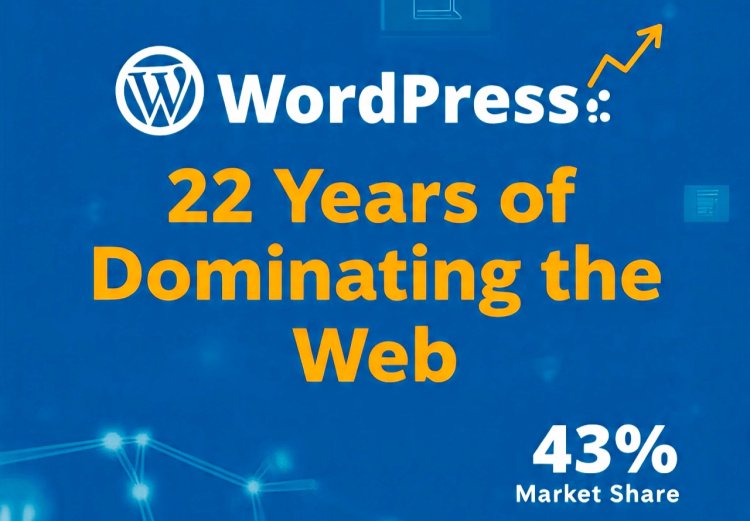How WordPress Came into the Market & Why It's Still Leading the World ?!
What started as 19-year-old Matt Mullenweg's frustrated blog comment in 2003 became the internet's backbone, with WordPress now powering 43.3% of all websites worldwide. Born from the need to make website creation accessible to everyone (not just programmers), WordPress evolved from a simple blogging tool into the world's dominant content management system through its open-source approach, massive ecosystem of 60,000+ plugins, and supportive global community. Today, it serves everyone from small businesses to major corporations like BBC and CNN, creating a $600+ million annual economy while continuing to innovate with AI integration and modern visual editing tools, proving that community-driven solutions can democratize technology and empower millions to share their voices online.

Picture this: In 2003, creating a website was like trying to build a car from scratch – you needed to be an engineer, mechanic, and designer all at once. Then along came WordPress, turning website creation into something as simple as writing in a diary. Today, over 22 years later, this humble blogging tool powers nearly half of all websites on Earth. How did a college student's side project become the internet's backbone?
Table of Contents
- Introduction
- The Origin of WordPress
- Early Challenges and Milestones
- WordPress Evolution Timeline
- The WordPress Ecosystem
- Why WordPress Became So Popular
- How WordPress Dominates the CMS Market Today
- Key Strengths That Keep WordPress on Top
- Challenges Faced by WordPress
- The Future of WordPress
- Conclusion
1. Introduction
Why Talk About WordPress?
Imagine if one company made almost half of all the cars in the world. That's essentially what WordPress has achieved in the website world. Every day, millions of people around the globe use WordPress to share their thoughts, sell their products, and build their businesses online.
Its Global Impact in 2025
The Numbers That Tell the Story:
- WordPress powers 43.3% of ALL websites worldwide
- Over 810 million websites run on WordPress
- 500+ new WordPress sites go live every day
- Available in more than 70 languages
- Used by everyone from neighborhood cafes to NASA
What This Means: If the internet were a city, nearly every other building would have a WordPress sign on it. From your favorite food blogger to major news outlets like BBC and CNN, WordPress is everywhere.
2. The Origin of WordPress
Background: The Pre-WordPress Era
Back in 2003, the internet felt like the Wild West. Creating a website meant:
- Learning complex programming languages
- Writing hundreds of lines of code by hand
- Hiring expensive developers for simple changes
- Spending weeks just to add a single page
The Problem: Ordinary people with great ideas had no easy way to share them online. It was like having a powerful voice but no microphone.
Founders: Matt Mullenweg & Mike Little
Meet the Heroes of Our Story:
Matt Mullenweg - A 19-year-old college student from Houston, Texas, who loved jazz music and had a personal blog. He wasn't trying to change the world; he just wanted better blogging software.
Mike Little - A British web developer who responded to Matt's blog post about improving existing blogging software. Sometimes the most powerful partnerships begin with a simple comment on a blog.
The Spark: In April 2003, Matt wrote a frustrated blog post about the limitations of existing blogging software called "b2/cafelog." Mike commented, suggesting they work together to create something better. That comment changed internet history.
Initial Release (2003): A Fork of b2/cafelog
The Birth Moment: On May 27, 2003, WordPress version 0.7 was released. It was built on the foundation of b2/cafelog (which had stopped being updated) but with big dreams for the future.
What Made It Special:
- Clean, simple design that anyone could understand
- Easy installation (for its time)
- Built-in comment system
- Template system for customization
Fun Fact: The name "WordPress" was suggested by Matt's friend Christine Selleck. It was chosen because it sounded professional and suggested the idea of "pressing" content onto the web.
3. Early Challenges and Milestones
First Major Updates
The Growing Years (2003-2005):
Version 1.0 "Davis" (January 2004):
- Named after jazz musician Miles Davis (Matt's passion for jazz influenced naming)
- Introduced search-friendly URLs
- Added moderation system for comments
Version 1.5 "Strayhorn" (February 2005):
- Revolutionary theme system launched
- Static pages feature added (not just blog posts anymore)
- Plugin architecture introduced
Real Impact: These updates transformed WordPress from a simple blogging tool into something much more powerful. It was like upgrading from a bicycle to a motorcycle – suddenly, much longer journeys became possible.
Community Growth & Open-Source Movement
The Magic of Open Source: WordPress chose to be "open source," meaning:
- Anyone could use it for free
- Developers worldwide could improve it
- No single company controlled it
- Community collaboration drove innovation
Community Milestones:
- 2004: First WordCamp (WordPress conference) organized
- 2005: Automattic company founded to support WordPress
- 2006: WordPress.com launched for hosted blogs
- 2007: First major corporate adoptions
Why This Mattered: Like a snowball rolling downhill, WordPress's community grew bigger and stronger each year. When thousands of smart people work together to improve something, magic happens.
Introduction of Plugins and Themes
Plugins: The App Store Before App Stores Plugins are like apps for your website. Need a contact form? There's a plugin. Want to sell products? There's a plugin. This system meant:
- Users could add features without coding
- Developers could build businesses creating plugins
- WordPress could stay lightweight while being infinitely expandable
Themes: Instant Website Makeovers Themes changed how websites looked without touching content. It was like having a complete wardrobe change for your website with just one click.
4. WordPress Evolution Timeline
From Blog Platform to Full CMS
The Transformation Journey:
2008-2010: The Expansion Era
- WordPress became a full Content Management System (CMS)
- Businesses started using it for complete websites, not just blogs
- Multi-site functionality introduced
2011-2015: The Maturation Period
- Responsive design became standard (websites that look good on phones)
- Better media management
- Improved user interface
2016-2020: The Modernization Phase
- REST API introduced (allowing WordPress to power mobile apps)
- Customizer launched (real-time website editing)
- Security improvements
Key Features Added Over the Years
Game-Changing Features:
- Custom Post Types (2010): Turned WordPress into a tool for any type of content
- Multisite Networks (2010): One WordPress installation could run multiple websites
- Theme Customizer (2012): Live preview while making changes
- REST API (2016): WordPress became the engine for mobile apps and other platforms
Gutenberg Editor & Modern UX
The 2018 Revolution: Gutenberg Block Editor
Traditional editing felt like using a typewriter in the smartphone age. Gutenberg changed everything:
Before Gutenberg:
- Writing felt like using an old word processor
- Adding images and layouts required technical knowledge
- Customization meant learning code
After Gutenberg:
- Drag-and-drop page building
- Visual editing with immediate preview
- Building pages like playing with digital building blocks
The Impact: Suddenly, creating beautiful, complex web pages became as easy as arranging furniture in a room.
5. The WordPress Ecosystem
Themes and Plugin Marketplaces
The Digital Economy WordPress Created:
Theme Marketplaces:
- ThemeForest: Over 12,000 WordPress themes
- Elegant Themes: Home of Divi, used by millions
- StudioPress: Premium themes for professionals
- WordPress.org: Thousands of free themes
Plugin Powerhouses:
- WordPress.org: 60,000+ free plugins
- CodeCanyon: Premium plugin marketplace
- Plugin developers earning millions annually
Real Numbers: The WordPress ecosystem generates over $600 million annually in theme and plugin sales alone.
Developers, Designers, and Agencies
The WordPress Job Market:
- Over 70,000 WordPress developers worldwide
- Thousands of WordPress-focused agencies
- Freelancers building entire careers around WordPress
- Job boards specifically for WordPress work
Success Stories: Many developers started with simple WordPress sites and built million-dollar agencies. It created an entire industry of opportunity.
WordPress.org vs WordPress.com
Two Brothers, Different Personalities:
WordPress.org (The Independent One):
- Free software you install yourself
- Complete control and customization
- You handle hosting and maintenance
- Like owning your own house
WordPress.com (The Managed One):
- Hosted service with monthly fees
- Limited customization but no maintenance
- Like living in a well-managed apartment
- Perfect for beginners
The Genius: This dual approach meant WordPress could serve everyone – from tech-savvy developers to complete beginners.
6. Why WordPress Became So Popular
Ease of Use & Flexibility
The Goldilocks Solution: WordPress hit the sweet spot – not too simple (like basic website builders) and not too complex (like enterprise systems). It was "just right" for most people.
Real-World Example: A local restaurant owner can:
- Update their menu in minutes
- Add photos of new dishes
- Post special events
- Take online orders
- All without calling a web developer
Open Source and Developer-Friendly
The Power of "Free":
- No licensing fees ever
- Complete source code available
- Freedom to modify anything
- Global community of contributors
Developer Love: Programmers chose WordPress because:
- Clean, well-documented code
- Huge community for support
- Endless customization possibilities
- Strong job market
Strong Community Support
The WordPress Family:
- 656 WordCamps held in 75 countries
- Local meetups in hundreds of cities
- Forums with millions of helpful answers
- Thousands of tutorials and courses
Community Impact: If you have a WordPress question at 3 AM, someone somewhere in the world is awake and ready to help. This 24/7 global support network is invaluable.
7. How WordPress Dominates the CMS Market Today
Market Share Statistics (2025 Update)
The Numbers Game:
- WordPress: 43.3% of all websites
- Shopify: 4.4% (primarily e-commerce)
- Wix: 2.6%
- Squarespace: 2.0%
- Joomla: 1.8%
- All Others: Combined less than WordPress alone
What This Means: For every WordPress website, there are barely two websites using all other systems combined. It's not just market leadership; it's market dominance.
Comparison with Other CMS Platforms
WordPress vs. The Competition:
Against Website Builders (Wix, Squarespace):
- More flexibility and power
- Better long-term scalability
- Larger community and resources
- Lower long-term costs
Against Enterprise CMS (Drupal, custom solutions):
- Much easier to use
- Faster deployment
- Lower development costs
- Massive plugin ecosystem
Against E-commerce Platforms (Shopify):
- More content management features
- Greater customization options
- Lower transaction fees
- Better for content + commerce combination
WordPress for E-commerce, Education, Media, and More
Industry Dominance:
E-commerce Success:
- WooCommerce (WordPress plugin) powers 28% of all online stores
- From small crafters to major retailers
- Billion-dollar companies run on WordPress + WooCommerce
Education Sector:
- Universities use WordPress for websites and learning management
- Online course creators choose WordPress for flexibility
- Student newspapers and academic blogs
Media and Publishing:
- Major news sites (BBC, CNN blogs, The New York Times blogs)
- Magazine websites and digital publications
- Podcasters and video creators
Real Impact: WordPress isn't just a tool; it's the foundation of entire industries online.
8. Key Strengths That Keep WordPress on Top
Scalability and Customization
Growing with Your Dreams:
Small Start, Big Possibilities:
- Begin with a simple blog
- Add e-commerce capabilities
- Expand to multiple languages
- Scale to millions of visitors
Customization Freedom:
- Change everything or nothing
- Custom functionality through plugins
- Unique designs through themes
- Complete control over appearance and behavior
Success Story: Many websites started as small WordPress blogs and grew into major online businesses, all while staying on the same platform.
SEO-Friendly Structure
Built for Google Success:
Technical SEO Advantages:
- Clean, semantic code structure
- Fast loading capabilities
- Mobile-responsive by default
- Proper heading hierarchy
SEO Plugin Power:
- Yoast SEO: Over 5 million active installations
- RankMath: Advanced SEO features
- Built-in optimization suggestions
- Automatic XML sitemaps
Real Results: WordPress sites consistently rank well in search engines, not by accident but by design.
Regular Updates and Security Features
Staying Safe and Current:
Security Commitment:
- Regular security updates
- Active security team
- Quick response to vulnerabilities
- Large community watching for issues
Continuous Improvement:
- Major updates 2-3 times per year
- Minor updates for security and bugs
- New features without breaking existing sites
- 22+ years of consistent development
9. Challenges Faced by WordPress
Performance and Speed Issues
The Growing Pains:
Common Speed Problems:
- Too many plugins can slow sites down
- Poorly coded themes affect performance
- Shared hosting limitations
- Database optimization needs
The Reality Check: WordPress can be as fast or slow as you make it. Like a car, it depends on how you maintain and use it.
Solutions Available:
- Caching plugins for speed
- CDN services for global performance
- Optimized hosting providers
- Performance monitoring tools
Plugin Vulnerabilities
The Double-Edged Sword:
Security Challenges:
- 60,000+ plugins mean varying quality
- Some developers abandon plugins
- Outdated plugins create vulnerabilities
- Users don't always update regularly
Protection Strategies:
- Security plugins like Wordfence
- Regular updates and maintenance
- Choosing reputable plugin developers
- Professional security monitoring
Competition from Modern Website Builders
The New Kids on the Block:
Modern Competitors:
- Webflow: Designer-friendly visual builder
- Squarespace: Beautiful templates, easy setup
- Wix: Drag-and-drop simplicity
- Ghost: Fast, focused on content
WordPress's Response:
- Block editor (Gutenberg) for visual editing
- Full-site editing capabilities
- Improved user experience
- Faster, more modern interface
10. The Future of WordPress
AI, No-Code Features & Full-Site Editing
The Next Generation WordPress:
AI Integration Coming:
- AI-powered content suggestions
- Automated SEO optimization
- Smart image optimization
- Intelligent spam detection
No-Code Revolution:
- Visual page builders becoming standard
- Drag-and-drop everything
- Custom functionality without coding
- Template libraries expanding
Full-Site Editing:
- Edit headers, footers, and templates visually
- Create custom layouts easily
- Design systems for consistent branding
- Real-time collaboration features
Growing Role in Enterprise & Omnichannel Publishing
Enterprise Adoption:
- Fortune 500 companies choosing WordPress
- Enterprise-level hosting and support
- Advanced security and compliance features
- Integration with business systems
Omnichannel Future:
- Content created once, published everywhere
- Mobile apps powered by WordPress
- Voice assistant integration
- IoT device content delivery
Headless WordPress:
- WordPress as content backend
- Frontend flexibility for developers
- API-first approach
- Modern JavaScript frameworks
11. Conclusion
Why WordPress Remains the Global Leader
The Perfect Storm of Success:
WordPress succeeded because it solved a real problem at the right time, in the right way. It democratized website creation, turning it from an exclusive skill into something accessible to everyone.
The Winning Formula:
- Timing: Launched when the internet needed easier website creation
- Community: Built by and for users, not shareholders
- Flexibility: Powerful enough for experts, simple enough for beginners
- Evolution: Constantly improving while staying true to its core mission
- Economics: Free to use, with endless opportunities to extend
Final Reflections on Its Journey and Future Potential
The Remarkable Journey: From a frustrated college student's blog post to powering nearly half the internet – WordPress's story is about the power of open collaboration and community-driven innovation.
Looking Ahead: As artificial intelligence reshapes technology and no-code tools become mainstream, WordPress is positioning itself not just to survive but to lead the next wave of internet innovation.
The Human Impact: WordPress has enabled millions of people to share their voices, build businesses, and create communities online. It's not just software; it's a platform for human expression and connection.
The Bottom Line: WordPress leads the world not because it's perfect, but because it's perfectly suited to human needs. It grows with you, adapts to changes, and puts power in the hands of people, not just programmers.
In a digital world that often feels controlled by a few giant corporations, WordPress remains a beacon of democratic technology – proof that the best solutions come from communities working together toward a common goal.
The Future Promise: As long as people have stories to tell, businesses to build, and ideas to share, WordPress will be there, evolving and improving, making the impossible possible for millions of users worldwide.
Twenty-two years in, and WordPress is just getting started.
What's Next?
Enjoyed learning about WordPress's incredible journey? There's so much more to explore in the world of web technology!
- Stay Updated: Subscribe to our newsletter for more easy-to-understand guides on CMS, web development, and digital marketing – delivered straight to your inbox.
- Got Questions? Drop a comment below! Whether you're curious about WordPress security, theme selection, or have a specific challenge – we're here to help. Your questions often become our next detailed articles.
- Found This Helpful? Share it with anyone who's thinking about starting a website or curious about how WordPress became so dominant. Knowledge shared is knowledge multiplied!
-Ready to start your WordPress journey or take it to the next level? Let's continue this conversation in the comments below.
What's Your Reaction?





















